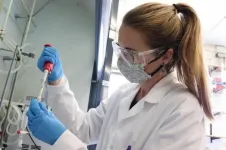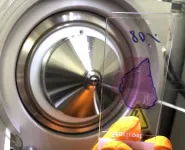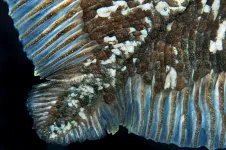CSIC scientists propose a new strategy to regulate the cells communication network
The new tool, designed at the IQAC-CSIC, can help to understand the origin of some diseases and the development of new drugs
2021-06-17
(Press-News.org) A study performed by researchers at the Institute for Advanced Chemistry of Catalonia (IQAC-CSIC) from the Spanish National Research Council (CSIC) in collaboration with Stony Brook University (USA) proposes a new strategy for the development of new drugs based on the inhibition of tyrosine kinase enzymes, molecules that activate and trigger many cellular processes. The results have been published in the Chemistry - A European Journal.
The new approach is based on the regulation of the signaling cascade of tyrosine kinases, and could lead to the development of improved and more selective tools for research, diagnosis or treatment of some diseases.
Tyrosine kinases are a set of enzymes that are essential for communication between the cells of our body, which trigger biochemical reactions that are important for life. "The dysfunction of these enzymes is related to serious diseases such as diabetes, some neurological disorders and many types of cancer," explains Ignacio Alfonso, a researcher at the IQAC-CSIC.
They activate different signaling pathways
Cell signaling is the process by which cells communicate. In the cell there are many types of receptors or specific proteins that recognize the proteins synthesized by the body and make the cell respond to them. One of the most important are tyrosine kinases.
"Cells receive signals from the environment when a molecule (a hormone, for example) binds to one of these receptors. The receptor recognizes the molecule and triggers a series of chemical reactions", explains Alfonso. This allows cells to work to control vital functions of the body, such as cell multiplication or destruction. Each process has its own signaling path. After the first molecule in the signaling pathway receives the signal, another molecule is activated, then another and another, and so on throughout the signaling cascade until cellular function is fulfilled. "The abnormal activation of signaling pathways can lead to diseases, such as cancer", says the researcher.
Kinases are a family of molecules that activate many different signaling pathways, which implies that they themselves participate in all of these processes. "When you want to avoid any of these processes, a research strategy is to inhibit kinases, blocking them with synthetic molecules. But this strategy is not very selective, since other important pathways may be inhibiting," warns Alfonso. In fact, the similarity between kinases and their functional versatility (the same kinase acts on different molecules and is involved in different processes) has made it difficult to design specific inhibitors to modulate pathological situations or dissect different functions in basic research.
Target: the place where kinases act
It is here where this work proposes an alternative strategy: not to inhibit the kinases, but to cover and block the molecules on which the kinases act. The tool for this would be artificial synthetic receptors, that is, synthetic molecules that would protect the place where the kinases exert their action. "Our group has designed molecules that interact with the substrates of the kinase, and not with the kinase" explains Alfonso. "We have prepared artificial molecular 'cages', made up of pseudopeptides, that are able to modulate the activity of these enzymes" clarifies the researcher.
"This complementary approach paves the way for selective modulation of an individual kinase-stimulated signaling pathway, without interfering with other functions of the kinase," explains Todd Miller from Stony Brook University. "This technology would enable investigators to dissect the contributions of specific signaling pathways in cellular function".
Despite being a proof-of-concept study, the results of this study could lead to more selective modulators/inhibitors of these kinases that would be used as research tools for the full understanding of this complex communication network. "This approach generates basic knowledge, which could be essential to better understand key biological functions and the origin of many diseases", concludes Dr. Alfonso.
INFORMATION:
[Attachments] See images for this press release:

ELSE PRESS RELEASES FROM THIS DATE:
2021-06-17
Today as they did 100 years ago, doctors diagnose cancer by taking tissue samples from patients, which they usually fix in formalin for microscopic examination. In the past 20 years, genetic methods have also been established that make it possible to characterize mutations in tumors in greater detail, thus helping clinicians select the best treatment strategy.
Even tiny tissue samples can be used to detect proteins
Now, a group of researchers from the Berlin-based Max Delbrück Center for Molecular Medicine in the Helmholtz Association (MDC), the Berlin Institute of Health (BIH), Charité - Universitätsmedizin ...
2021-06-17
The German National Academy of Sciences Leopoldina and the German Council for Sustainable Development (RNE) have published a joint position paper presenting paths to climate neutrality by 2050. In it, the Leopoldina and the RNE highlight options for action to effect the changes needed within society, at political level and in the business world, in view especially of the urgency and the historic dimensions of the transformation we face. With the paper, the Leopoldina and the RNE are consciously not seeking to engage in a race to set the most ambitious target. They are instead offering an options paper for setting the right course and covering the key implementation steps. ...
2021-06-17
Abu Dhabi, UAE: Trans-Neptunian Objects (TNOs), small objects that orbit the sun beyond Neptune, are fossils from the early days of the solar system which can tell us a lot about its formation and evolution.
A new study led by Mohamad Ali-Dib, a research scientist at the NYU Abu Dhabi END ...
2021-06-17
Chemical engineers at the University of Illinois Chicago and UCLA have answered longstanding questions about the underlying processes that determine the life cycle of liquid foams. The breakthrough could help improve the commercial production and application of foams in a broad range of industries.
Findings of the END ...
2021-06-17
The glaciers of Nanga Parbat - one of the highest mountains in the world - have been shrinking slightly but continually since the 1930s. This loss in surface area is evidenced by a long-term study conducted by researchers from the South Asia Institute of Heidelberg University. The geographers combined historical photographs, surveys, and topographical maps with current data, which allowed them to show glacial changes for this massif in the north-western Himalaya as far back as the mid-1800s.
Detailed long-term glacier studies that extend the observation period ...
2021-06-17
DALLAS, June 16, 2021 -- Findings from a small study detailing the treatment of myocarditis-like symptoms in seven people after receiving a COVID-19 vaccine in the U.S. are published today in the American Heart Association's flagship journal Circulation. These cases are among those reported to the Centers for Disease Control and Prevention's Vaccine Adverse Event Reporting System (VAERS) documenting the development of myocarditis-like symptoms in some people who received the COVID-19 vaccine.
Myocarditis is a rare but serious condition that causes inflammation of the middle layer of the wall of the heart muscle. It can weaken the heart and affect the heart's electrical system, which keeps the heart pumping regularly. It is most often the result of an infection and/or ...
2021-06-17
They're cute, they're furry, and they start diving into frigid Antarctic waters at 2 weeks old. According to a new study from California Polytechnic State University, Weddell seal pups may be one of the only types of seals to learn to swim from their mothers.
Weddell seals are the southernmost born mammal and come into the world in the coldest environment of any mammal. These extreme conditions may explain the unusually long time they spend with their mothers.
The study, "Early Diving Behavior in Weddell Seal (Leptonychotes Weddellii) Pups," was published earlier this month in the Journal of Mammalogy.
According to the Seal Conservation Society, adult Weddell seal females are ...
2021-06-17
Once thought to be extinct, lobe-finned coelacanths are enormous fish that live deep in the ocean. Now, researchers reporting in the journal Current Biology on June 17 have evidence that, in addition to their impressive size, coelacanths also can live for an impressively long time--perhaps nearly a century.
The researchers found that their oldest specimen was 84 years old. They also report that coelacanths live life extremely slowly in other ways, reaching maturity around the age of 55 and gestating their offspring for five years.
"Our most important finding is that the coelacanth's age was underestimated by a factor of five," says Kélig Mahé of IFREMER Channel and North ...
2021-06-17
The birth of a human being requires billions of cell divisions to go from a fertilised egg to a baby. At each of these divisions, the genetic material of the mother cell duplicates itself to be equally distributed between the two new cells. In primary microcephaly, a rare but serious genetic disease, the ballet of cell division is dysregulated, preventing proper brain development. Scientists from the University of Geneva (UNIGE), in collaboration with Chinese scientists, have demonstrated how the mutation of a single protein, WDR62, prevents the proper formation of the cable network responsible for separating genetic material into two. As cell division is then slowed down, the brain ...
2021-06-17
BOSTON - An antibiotic developed in the 1950s and largely supplanted by newer drugs, effectively targets and kills cancer cells with a common genetic defect, laboratory research by Dana-Farber Cancer Institute scientists shows. The findings have spurred investigators to open a clinical trial of the drug, novobiocin, for patients whose tumors carry the abnormality.
In a study in the journal Nature Cancer, the researchers found that in laboratory cell lines and tumor models novobiocin selectively killed tumor cells with abnormal BRCA1 or BRCA2 genes, which help repair damaged DNA. The drug was effective even in tumors resistant to agents known as PARP inhibitors, which have become a prime therapy for cancers with DNA-repair glitches.
"PARP inhibitors ...
LAST 30 PRESS RELEASES:
[Press-News.org] CSIC scientists propose a new strategy to regulate the cells communication network
The new tool, designed at the IQAC-CSIC, can help to understand the origin of some diseases and the development of new drugs




